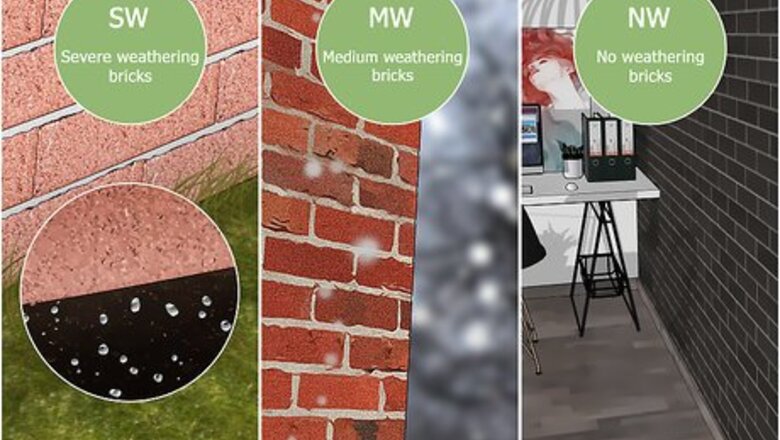
views
Preparing the Wall
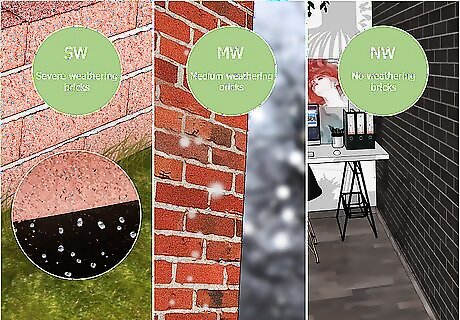
Select your bricks. There are many varieties of brick, but they all fall into three main categories: Severe weathering (SW) bricks can withstand direct contact with the ground and moisture. Use these for foundations, patios, garden walls, and so on. Medium weathering (MW) bricks can withstand freezing temperatures and above ground exterior work (not direct ground contact). No weathering (NW) bricks are for interior work only.
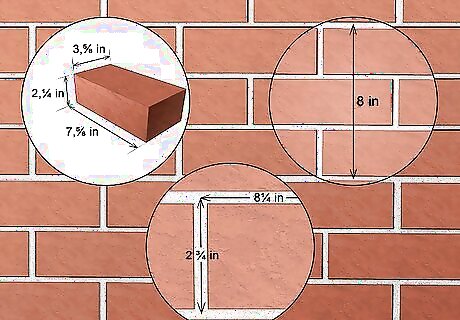
Purchase the right amount of bricks. Bricks come in a variety of shapes and sizes, but the most important thing to remember is that you must adjust the size bricks you buy to account for the mortar. The most common brick, a modular brick, has "specified" dimensions 3⅝" wide, 2¼" tall, and 7⅝" long (even if they are sold under nominal whole number measurements). They are typically used with mortar joints ½" thick. Taking the mortar into account, each brick will take up 4⅛" x 2¾" x 8¼" of space. You must add the mortar measurements when planning your wall. The combination measurement of brick and mortar is called the brick's "nominal" size. Three rows of bricks stacked on top of each other will be 8" tall. For example, to make a wall 2 ft tall x 6 ft long, calculate (24" / 2¾") for height and (72" / 8¼") for length, rounding up. In this case, you'll need 81 bricks, 9 rows tall x 9 bricks long. Purchase at least five extra bricks to cut in half to begin new rows, plus an additional one brick per row in case of damaged bricks. If the ground is uneven or sloped, plan to install an additional one or two rows of bricks below the finished grade level to create a level base.
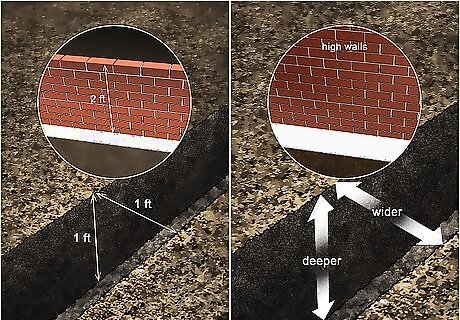
Dig out a trench for your foundation. You need to dig out a trench to seat the wall in, which you then make solid with a layer of concrete. This is often called a footer, or concrete foundation. Dig out a rectangular trench the length and width of your planned wall, roughly 1 foot deep. If your wall is more than 2 feet tall, you may need a deeper or wider trench. If the "footer" you install (as described below) is not strong enough to support the wall, the wall can sag or collapse. You can look up recommended dimensions online based on your soil's load bearing capacity and the size of your project. Make sure the footer will have good water drainage away from the wall. Water pooling around the footer can cause wall failure.
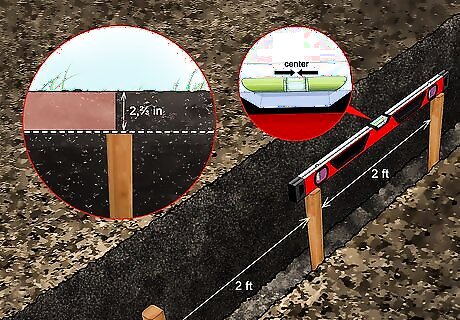
Drive level wooden stakes into your trench. Take several wooden stakes and drive them into the soil so that the tops of them are all level. Find the nominal height of your bricks (the height of the bricks plus 1/2" for mortar), then drive the posts so that they are all this height below the top of the trench. Use a level to ensure that the tops of the stakes are completely level. For this example, with 2-2/3" bricks, you would want 2-2/3" of space between the top of your guide posts and the lip of the trench. This is so the first row of bricks is completely seated in your foundation. Space these posts 2-4 feet apart, depending on the length of your wall.
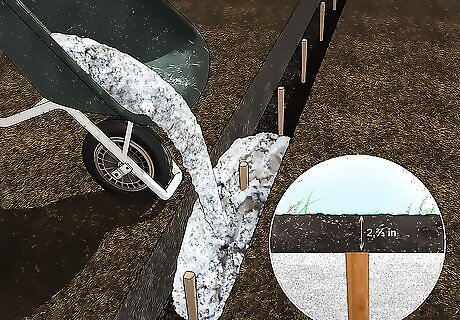
Mix and pour concrete up to the top of the guideposts. Fill in the trench up to the top of the stakes, leaving the space you measured for your bricks. The concrete needs 2-3 days to dry and set, so use this time to start gathering supplies and preparing your measurements. Use a finishing trowel to make sure the top of the concrete is smooth and level before it starts drying. You can notch a "keyway joint" or "V" into the middle of the footer to help interlock it into the mortar bed.
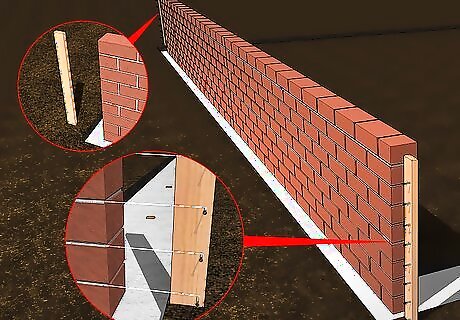
Make your guideposts. Also called gauging rods, these will ensure that your wall is level. Take 2 long wooden boards or posts and measure out each row of the brick wall, also known as a course. Mark the boards where each brick should be, including the mortar lines. Make sure you can drive the posts into the ground so that they can be freestanding. They should be as tall as your wall will be. For the 2x6ft wall, make a mark 2-1/4" up from the bottom -- this is the height of the first brick. Make another mark 1/2" above that, then continue this pattern up to the top of the wall, here 2 feet high. You want two of these, one for each side of the wall. These rods will be the rulers for your wall, and need to be identically lined up. Use a level and your tape measure to make sure the wall is immaculately planned.
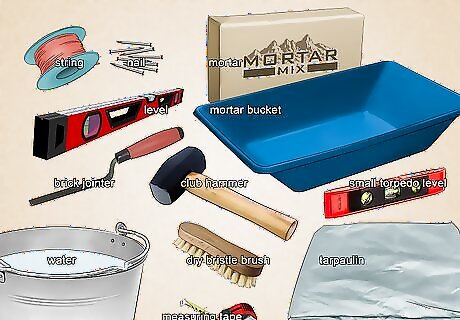
Gather your supplies while the foundation dries. You'll need quite a bit of stuff to build your wall, all things considered. Once the foundation is set and your guideposts are built, it's time to get your building materials in order. You will need: String and clamps/nails (to create guidelines) Mortar and a mixing bucket Level Brick jointer Club hammer Tape measure Water Dry bristle brush Tarps or plywood to lay at base of wall Small torpedo level to check individual bricks 4 ft level
Building The First Row
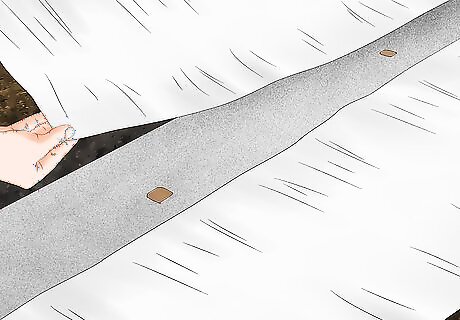
Put down tarps or plywood to catch mortar. Lay down tarps or 2 ft wide plywood at the base of the wall to catch excess mortar as it falls. Keep this surface clean and avoid walking on it so you can reuse this mortar.
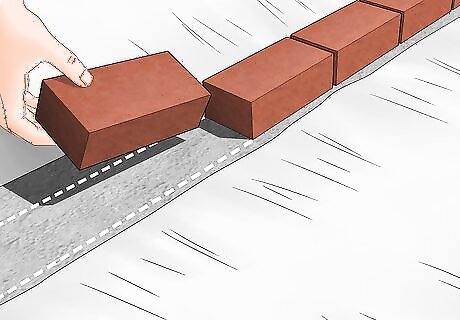
Lay your first row of bricks in the foundation for a dry run. Space them out appropriately, accounting for the mortar. Use your tape measure to make sure that they are the correct distance apart, and make sure that they fit in the trench snugly. Plan out the whole first row like this before you start any work. If you do not have bricklaying experience, read through this entire section first. You may need to practice a few techniques before you begin.
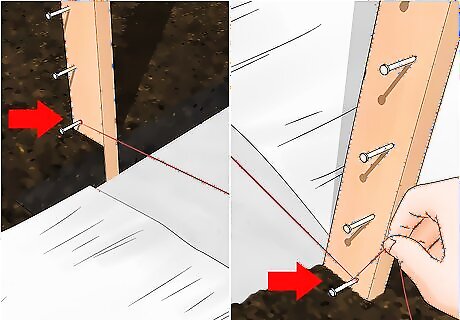
Clamp a string on your first guideline. This is going to be for the second layer of bricks, as the first one will be buried in the trench. Run the string from one gauging rod to the other so that you have a straight, level line to work with. Don't let the line sag. This must be kept "true" for a solid, level wall without major structural issues. It's really important that you ensure everything is symmetrical and perfectly squared for the first 2-3 courses so the rest of your brick wall turns out straight and even.
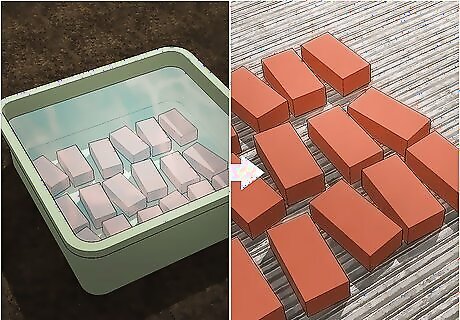
Soak the bricks and let dry. Soak the bricks in water, then lay them out to drip dry. The bricks should be thoroughly wet so the mortar bonds correctly. That said, wait until there is no more water running off the bricks, or the mortar may become too runny.
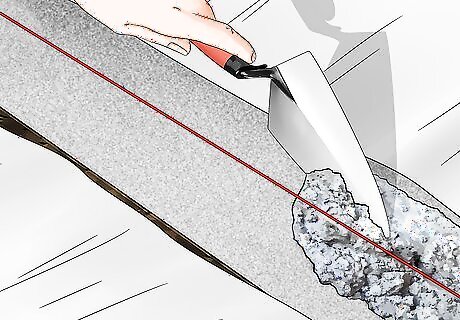
Lay the first 1/2 inch of mortar along the base of the foundation. When in doubt, add a little bit extra mortar, as you will be pushing the brick down slightly. Use your trowel to lightly press into the mortar along the center line, leaving little intents. The mortar will look like little waves.
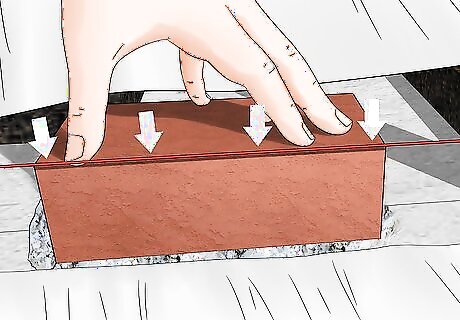
Press the first brick into the mortar. Push down slightly, then use your level to check that the brick even with the ground. To do so, press the level up against the side of the brick and then check it with your string sting line. Scrape any excess mortar down the line. You can use this mortar for the next bricks as long as it is free from contaminants.
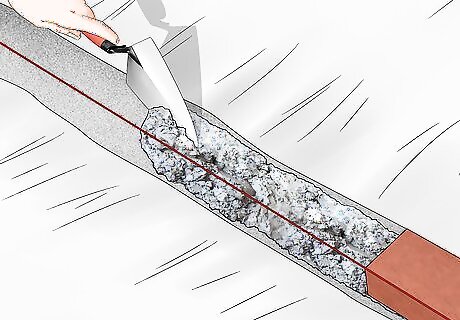
Lay mortar down for the next 2-3 bricks. Once you're sure your first brick is set, lay down some mortar for the next few. You only want to work with 2-3 bricks worth of mortar at a time.
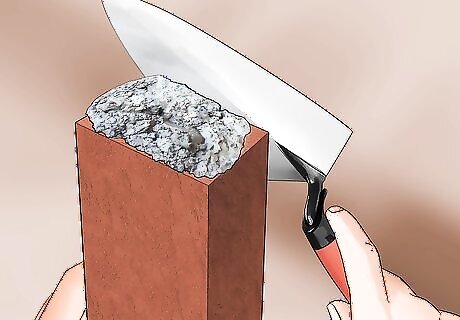
Butter the end of the next brick with mortar and press it into place. Take a slab of mortar and coat the end of the brick that will be pushed up against the first brick. You want a nice, even pat of mortar, just a little more than a 1/2" worth. Press it into place against to the first brick and use your tape measure to make sure they are 1/2" apart and joined by mortar. This is a very important step that ensures a strong bond between bricks. If you skip this and try to fill the mortar in between laid bricks, the joint will eventually fail. For best results, practice this several times on spare bricks before you move on to the real wall.
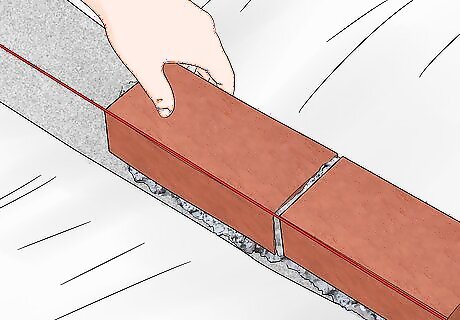
Press the brick lightly into the 1/2" of mortar you've laid down so that it is level with the first brick. Use the level to ensure that the bricks are flush and at an even height, pushing on them lightly to make sure that they are perfect.
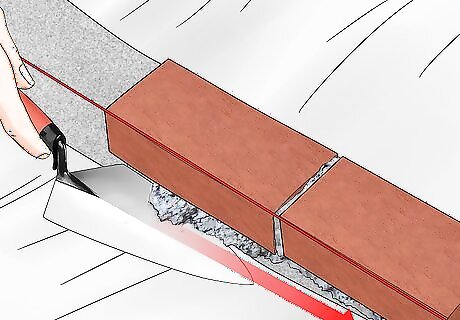
Scrape away any excess mortar as you work. You've pressed the bricks together, you'll notice that mortar starts to squeeze out as you work to get 1/2" joints. Use your trowel to scrape the mortar away and down onto the tarp or plywood at the base of the wall. As long as that surface is kept clean, you can reuse the mortar for the next brick.
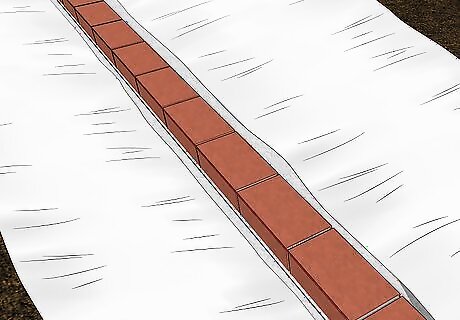
Keep adding bricks until the row is finished. Continue laying bricks down in this fashion -- mortar bottom and side, press in, check evenness with the level-- until your first row, or course, is complete. You can never check if the wall is level enough. You should be using your level and tape measure with almost every brick.
Building Additional Rows
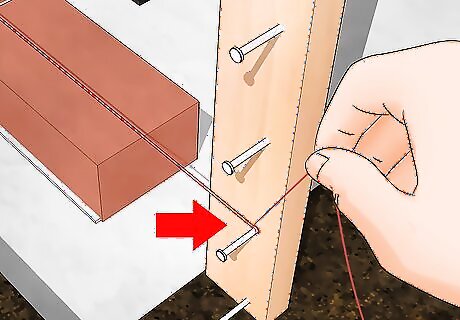
Move your guideline up to the next marker. It should be the 1/2 mortar marker that joins your 1st and 2nd rows. For the second row it should already be in place, but you need to remember to move the line each time you move up a row so that you know the height you have to hit.
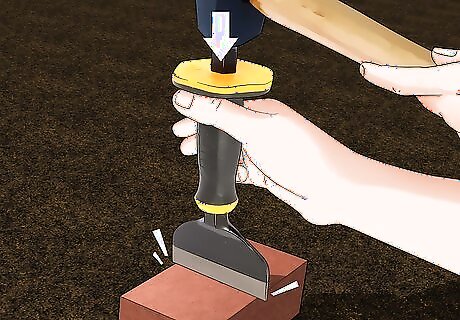
Cut a brick in half with a firm tap from the pointed end of a hammer. You can also use a bolster, which may make a cleaner cut. Still, bricks are meant to break cleanly. Tap on the point you want to cut the brick with the back of a hammer until you see a crack, then hit this spot hard, once, to cut the brick in half. You need to stagger your bricks, meaning that one brick in the second row sits on two bricks in the row below it. To do this, you'll start every other new row with half a brick. You don't need a perfectly clean, smooth cut. The rough edges will help hold the mortar.
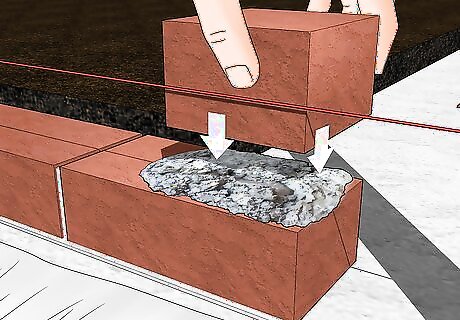
Start the second row with 1/2 a brick on both ends. You do not want to make the next row right on top of the first one, so that the joints line up. Mortar and place the half brick, then place a full brick next it like normal. Do this on both ends of the wall, so that each side has a half brick and a full brick in place.
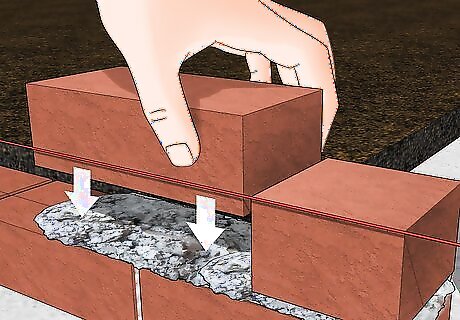
Mortar and place one full brick on top of your ends. To help you stay level, you build the ends of the wall up a course higher than you're working on, making it appear like there are staircases on the ends of the wall. You then fill in the bottom row, build the sides up a little higher, then continue until you reach the top. Remember to use the guideline and your level together to make sure the bricks are even and at the right height. Your gauging rods should help you place the end bricks, as they will line up right with the marks planted at the end of your wall.
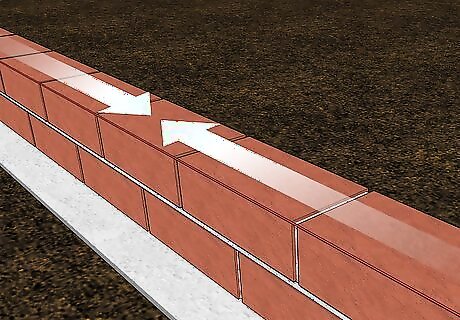
Fill in the entire bottom row. Place roughly 1/2" of mortar down, press the brick into place, check the straightness with the guideline and level, and wipe up any excess mortar. Then repeat until the second row is done.
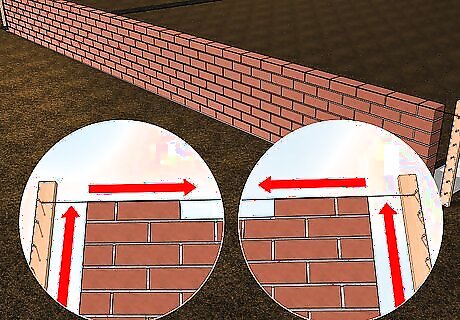
Continue building your wall from the ends inward. You want to have the ends of your wall one course higher than the row you are currently working on. This is especially important if the wall has pillars on either end. With each row, the process is the same. However, remember to use half-bricks every other row to ensure that the joints in each row are not perfectly lined up. Move the guideline. Apply mortar. Press a brick into either end of the wall, using the guidelines and level to make sure they are at the right height. Do the same thing one row above the one you're currently working on. Measure, mortar, and build the bottommost row, (infill the courses). Repeat the process one row higher.
Finishing the Wall
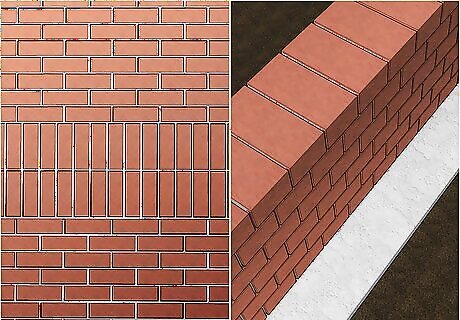
Try unique brick patterns for the top of the wall. Depending on what you built, you can finish your wall by turning or angling your bricks differently at any time. Popular options include: Soldiering, or standing the bricks up so that they are up straight, like soldiers at attention. Headers are when the shortest side of the brick points out. The top row of bricks is spun 90 degrees from the bottom one.
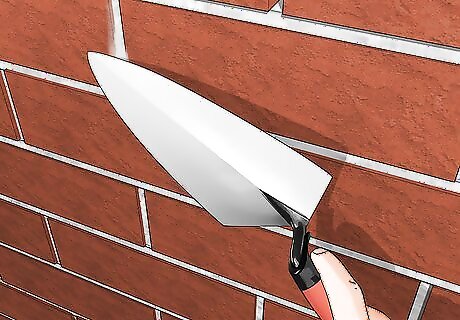
Fill in any missing patches of mortar along the wall. Use your trowel to fill in any patches or gaps in the joints, making sure there is a nice, even amount of mortar holding your wall together. Wait roughly 45-60 minutes before continuing -- the mortar should be slightly hardened, but not set, before moving on.
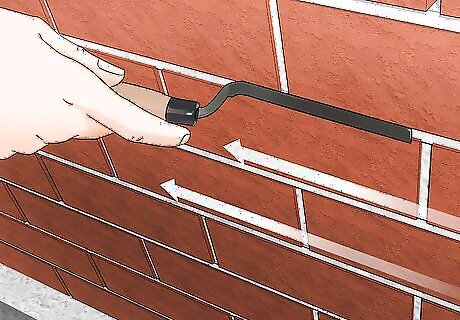
Use a brick jointer to indent the mortar professionally. Brick jointers are cheap little tools that help you get the professional, curved in joints on your wall. Firmly press the tool into the joints and run it down the mortar, trimming and polishing your wall.
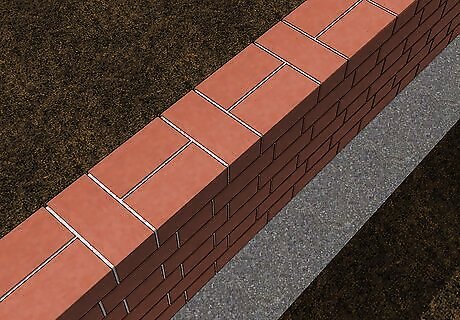
Consider other jointing patterns for your wall. A single brick width wall is easy to make, but not incredibly strong. More common is a double-brick wall, which can be easily adapted to your needs. Instead of alternating half bricks with full ones you simply need to alternate turning each brick on the ends, since 1 brick is as long as the width of two bricks. Every other row would begin with a brick that faces perpendicular to the direction of the wall, helping you keep the joints staggered. To help you remember where to place the bricks, think of how the wall looks when you're facing it. Every other row has a small, "square" brick, followed by the long bricks running parallel to the wall.
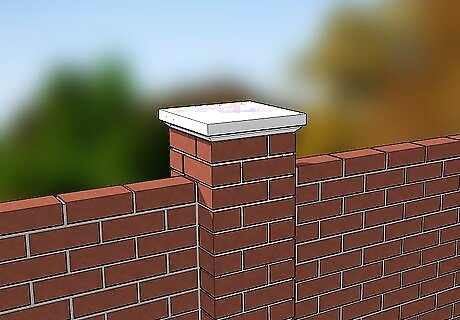
Add pillars to your design. Pillars are not incredibly difficult to add, but they do take some planning. They are basically squared "mini-wall," designed so that half of middle bricks "pokes out" into the wall, connecting everything together. Once you've decided on your pillar design, make sure you build them up at least 1-2 rows higher than the courses in between. You need to build the pillars up a few rows, then fill in the wall between them, only getting to the top of the wall after you've already finished both pillars.



















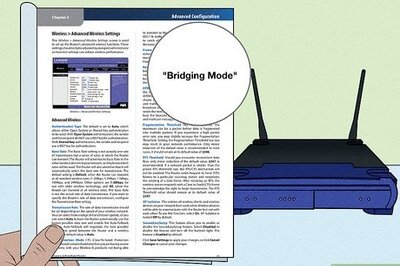
Comments
0 comment